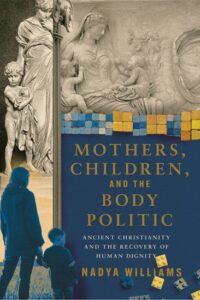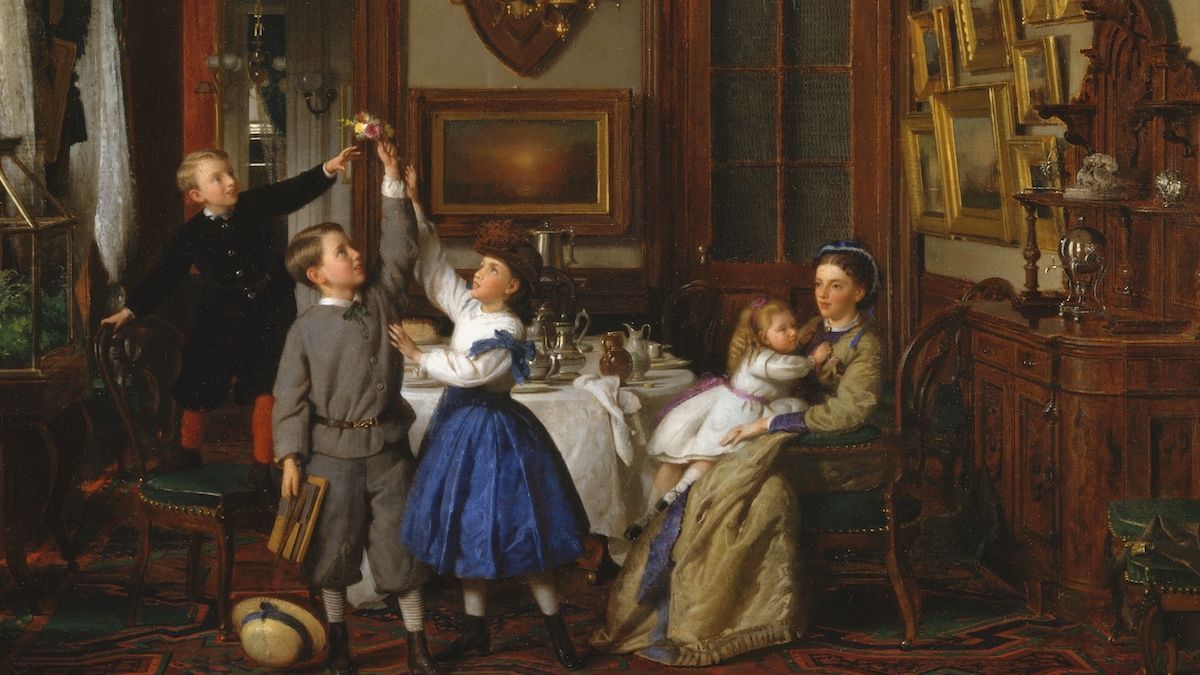Looking back from our twenty-first century vantage point, it is easy to draw a straight line between first-wave feminists and our rolling sexual revolution. Easy, but wrong.
It’s true that the entrance of women into the world of nineteenth-century politics introduced a new type of political discourse and a new set of political values. But that vision wasn’t aimed at imitating the autonomy and sexual freedom of debauched men. Instead, first-wave feminists prioritized the distinctive interests of women and children—and therefore placed the good of the family at the heart of their reformist agenda.
In 1902, British journalist W.T. Stead credited nineteenth-century women reformers with “compelling women… to serve the State in the promotion of all that tends to preserve the purity and sanctity of the home.” Indeed, in 1884, early women’s rights advocate Frances Willard explained, “Were I asked to define in a sentence, the thought and purpose of the Woman’s Christian Temperance Union, I would reply: It is to make the whole world HOMELIKE.” Rather than seeking political power, wealth, or sexual dominance, these women injected into the political sphere a vision of a state in service of the interest of the family.
This nineteenth-century vision for women in politics—rooted as it is in a recognition of the equal dignity and sexual asymmetry of men and women—provides a case-study in sex-realist feminist politics. A false dichotomy tells women they must choose between the sexual revolution or the patriarchy. But Frances Willard says with St. Paul, “Yet I show you a more excellent way.”
The Social Purity Movement
Nineteenth-century women and mothers recognized the destabilizing effects of industrialization on family and economic life, and they worked to counteract its ill effects in novel and lasting ways. From temperance to suffrage, these women aimed to transform politics in keeping with distinctive feminine values. Nowhere did this movement of women carry more weight than in the sphere of public sexual ethics, then known as the “social purity movement.”
The language of social purity (“social” being a scarcely veiled euphemism for “sexual”) has doubtless fallen on hard times. Particularly since the sexual revolution, the movement has often been dismissed as prudish, Puritanical, and sexually repressive. As Alison Parker acknowledged in 1997, “For a generation… most historians have simply accepted as a given that ‘purity’ campaigns were a misguided and deplorable residue of ‘Victorian prudery.’” But to its nineteenth-century advocates, the meaning of the movement was as simple as its mission: fighting a system that gave men a free pass for immoral or abusive behavior and left women to bear the consequences alone. As Sheila Rowbotham has written, “Social purity campaigners sought to protect women and children from male sexual desire.”
Of course, double standards for sexual ethics have existed from time immemorial. It was well-known that eighteenth-century legal theorists such as Montesquieu, Pothier, and John Taylor advocated that women who violated their marriage vows should be punished more harshly than men. As one of Tolstoy’s characters in Anna Karenina recognized, “the infidelity of the wife and the infidelity of the husband are punished unequally, both by the law and by public opinion.”
Nineteenth-century feminists like Frances Willard were determined to do something about this double standard. But they did not respond by calling for fewer restrictions on sexual behavior. Rather, they called for equal restrictions of sexual behavior.
It is precisely in this regard that the first-wave feminists modeled a “more excellent way” than the sexual revolution. Instead of holding men and women to an equally low standard of sexual ethics, first-wave feminists held both to an equally high standard of chastity, monogamy, and marital fidelity. As Kristin Kobes Du Mez has written, “Rather than advocating greater sexual license for women, purity reformers insisted that men, as well as women, ought to exercise sexual restraint.” Christian morality, as Louise Perry and Erika Bachiochi have both argued, “demanded the same chastity of men as of women.” As such, the social purity movement can be understood as a sex-realist movement by women, for women.
Woman reformers like Frances Willard, Josephine Butler, and countless others urged greater sympathy for female victims of male immorality and greater legal protection of women from unrestrained male sexual desire. These woman reformers fought the social purity fight simultaneously on two fronts: Abolishing the government-regulation of prostitution and passing age-of-consent laws.
Fighting the Sexual Exploitation of Women and Girls in Britain
In England, Josephine Butler formed the International Federation for the Abolition of State Regulation of Vice in 1876 to abolish the dehumanizing sexual exploitation of women and girls in Europe’s vast market of government-regulated prostitution. Between 1864 and 1869, the British parliament had passed a series of laws known as the Contagious Diseases Acts. Framed as hygienic measures to protect the health of British soldiers, the laws permitted the forced examination for venereal disease of any woman suspected of prostitution. Butler eloquently compared state-regulated prostitution in Europe to chattel slavery in the New World: “It is the final and most complete expression of the foul idea of woman as a chattel, a slave, an instrument, a mere vassal, officially dedicated to the vilest uses.” Yet while these laws entrusted local authorities with police-power to imprison disease-bearing women indefinitely, no equivalent measures could be inflicted upon the disease-bearing men who frequented the prostitutes.
This injustice—the legalized sexual exploitation of women—provoked a firestorm of criticism from Josephine Butler and her fellow reformers. By 1885, Butler’s campaign convinced the British Parliament to pass the Criminal Law Amendment Act of 1885, raising the age of consent from 13 to 16 and criminalizing many of the activities associated with child prostitution. The following year, in 1886, parliament repealed the Contagious Diseases Act.
Butler attributed the success of her campaign to the solidarity of women banding together across the world to protest the government-sanctioned sexual exploitation of women and girls through a dehumanizing system of regulated prostitution.
Thus the women of the world are reaching out their hands to each other, and banding themselves together, so that when councils, rulers, and lords of science endeavor, by decrees or by social tyranny, to give a continuance to the most degrading institution which has defiled the history of the human race, they will have the power to say: “You shall not slay us or our sisters.”
She was right. Across the Atlantic, Josephine Butler’s example awakened American women’s consciences to adopt social purity as a critical aspect of their social reform efforts.
The American Cause of Temperance and Purity
The Woman’s Christian Temperance Union (WCTU) had been founded in 1874 to promote temperance. But through the influence of WCTU president Frances Willard, the WCTU soon made passing state age-of-consent laws a core part of the movement’s platform. In fact, by 1894 Willard would refer to the work of the WCTU as “the cause of Temperance and Purity.”
For Willard, woman’s suffrage, temperance, labor reform, and chastity were all common strands of a pro-family, pro-woman social agenda. An “equal standard of purity for men and women,” Willard wrote in 1894, could “alone can make home happy.” In fact, Willard would go so far as to insist that the “Social Purity” was the end goal toward which all other reforms—Temperance, Labor Reform, and Suffrage—were tending. “The social purity movement could only come after its heralds the three other reforms I have mentioned were well under way,” declared Willard in 1887. Even suffrage, for Willard, was never an end in itself but a means toward the end of a more just society: a world where woman could become “what God intended her to be and Christ’s Gospel necessitates her being: the companion and counselor, not the incumbrance and toy of man.”
Toward this end, the WCTU organized rescue missions for survivors of trafficking, sexual exploitation, and prostitution. But as Peggy Pascoe discovered in her study of rescue homes in the American western frontier, this was often a fight women had to take on alone. “Home mission women found that some of the very middle-class men they expected to be their allies failed to share the same sense of urgency.” Still women pressed on.
As Frances Willard explained, she wanted to change the perception of prostitutes from being seen as “the fallen woman, or the impure woman so much as the knocked down woman.” If wider society could recognize the widespread sexual mistreatment of women as exploitation, legal redress could be taken.
Politically, the WCTU focused its efforts on passing age-of-consent laws, which would criminalize sexual activity—whether consensual or otherwise—under a certain age. The absence of these laws made the prosecution of rape and child sex trafficking virtually impossible. In 1886, most states had the age of consent set at 10 or 12, if they had an age of consent law at all. One state had the age of consent set at 7. As Willard told an audience in Philadelphia in 1885, “in Massachusetts and Vermont it is a greater crime to steal a cow than to abduct and ruin a girl.”
The WCTU’s political lobbying efforts were hugely successful. Through advocating directly to state legislatures, the WCTU succeeded in raising the age of consent in dozens of states, on average, from age 10 in 1886 to age 14 by 1895. By 1900, 32 states had passed age-of-consent laws, ranging between ages 14 and 18.
Sex-Realist Activism
Despite these innovative legislative accomplishments and dynamic social vision, the woman reformers of the social purity movement are too-often either vilified and cancelled or “memory-holed” and forgotten. In his 1977 book Vice and Vigilance, Edward Bristow famously caricatured the social purity movement as a “witch-hunt” that did little more than induce greater anxiety among young men for masturbating. As one historian has noted, “Historians, whose vision has been blinked by the ideology of the ‘sexual revolution,’ have tended to see social purity as simply an evangelical, anti-sex, repressive movement.”
But what if social purity activists were right to recognize that the injustice of women bearing the consequences of male sexual immorality would not be solved by women mimicking male debauchery? What if their attempt at taming the destructive force of sexual license constituted an example of woman’s empowerment rather than its absence? What if nineteenth-century women rightly recognized, as one author has noted, that “permissive male sexual behaviors threatened something cherished deeply by women: marital fidelity and familial stability”?
As Jonathan Z. Smith put it, “The historian’s task is to complicate, not to clarify.” Contemporary authors on the right and left often share the same false perception of first-wave feminists as progenitors of the sexual revolution. But a careful examination of the long-forgotten voices of nineteenth-century women yields a conclusion as refreshing as it is common-sensical. In a word, these woman reformers focused on promoting the interests of women and children by confronting male sexual immorality through moral suasion and political legislation.
A sex-realist feminist approach to woman’s political activism recognizes that women bring a distinctive and essential set of shared values to the public square. Nineteenth-century reformers like Josephine Butler and Frances Willard argued for women’s suffrage in no small part because they believed that only women would and could do something about the legal and cultural double standard of sexual ethics. Men showed little willingness to redress problems of human trafficking and the sexual abuse of women—problems in which many of them were complicit. So women stepped up. They did so not by arguing that women ought to enjoy the same degree of sexual autonomy afforded men, but that men ought to be held to the same high standards of sexual morality expected of women.
“Making the world home-like” was more than a motto for Frances Willard. It was a mission: a distinctive vision of social life and existence built on something larger and grander than the accumulation of wealth and the pursuit of sexual release. It was a vision that placed the well-being of women and children at the center of a progressive and pro-woman reformist agenda. It was a vision that recognized sexual asymmetry as a gift, not a burden, and placed the good of family at the center of social, cultural, and political life. And it is a vision that is in need of recovery today.



